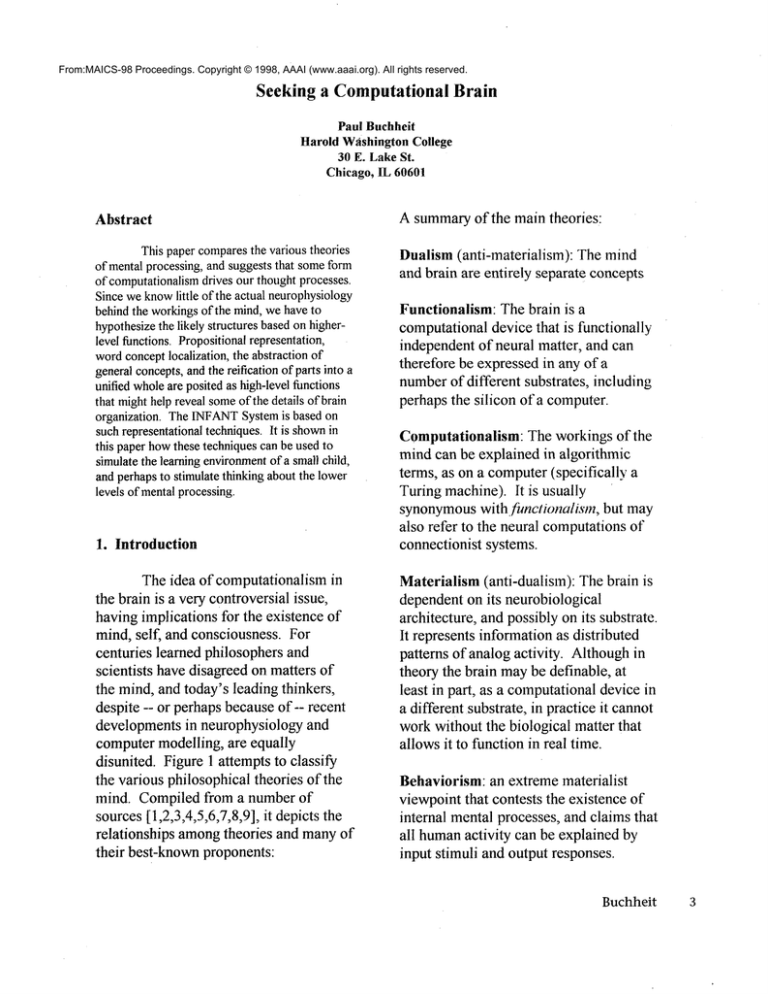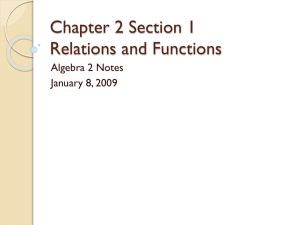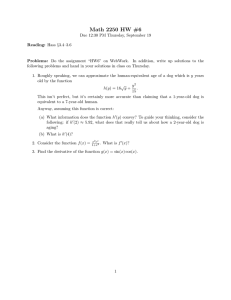
From:MAICS-98 Proceedings. Copyright © 1998, AAAI (www.aaai.org). All rights reserved.
Seeking a Computational
Brain
Paul Buchheit
HaroldW~tshington
College
30 E. LakeSt.
Chicago,IL60601
Abstract
A summaryof the main theories:
Thispapercompares
the varioustheories
of mentalprocessing,andsuggeststhat someform
ofcomputationalism
drivesourthoughtprocesses.
Sinceweknow
little of the actualneurophysiology
behindthe workings
of the mind,wehaveto
hypothesize
the likelystructuresbasedonhigherlevelfunctions.Propositional
representation,
wordconceptlocalization,theabstractionof
generalconcepts,
andthereificationof partsintoa
unifiedwhole
are positedas high-levelfunctions
that mighthelprevealsome
of thedetailsof brain
organization.TheINFANT
Systemis basedon
suchrepresentational
techniques.
It is shown
in
this paperhowthesetechniques
canbe usedto
simulatethelearningenvironment
of a smallchild,
andperhapsto stimulatethinkingaboutthe lower
levelsof mentalprocessing.
Dualism(anti-materialism): The mind
and brain are entirely separate concepts
1. Introduction
The idea of computationalismin
the brain is a very controversial issue,
havingimplications for the existence of
mind, self, and consciousness. For
centuries learned philosophers and
scientists have disagreed on matters of
the mind, and today’s leading thinkers,
despite -- or perhaps becauseof-- recent
developments in neurophysiology and
computermodelling, are equally
disunited. Figure 1 attempts to classify
the various philosophical theories of the
mind. Compiled from a number of
sources[1,2,3,4,5,6,7,8,9], it depicts the
relationships amongtheories and manyof
their best-knownproponents:
Functionalism:The brain is a
computationaldevice that is functionally
independent of neural matter, and can
therefore be expressed in any of a
numberof different substrates, including
perhaps the silicon of a computer.
Computationalism:The workings of the
mindcan be explained in algorithmic
terms, as on a computer(specifically
Turing machine). It is usually
synonymouswithfunctionalism, but may
also refer to the neural computationsof
connectionist systems.
Materialism(anti-dualism): The brain
dependent on its neurobiological
architecture, and possibly on its substrate.
It represents informationas distributed
patterns of analog activity. Althoughin
theory the brain maybe definable, at
least in part, as a computationaldevice in
a different substrate, in practice it cannot
workwithout the biological matter that
allows it to function in real time.
Behaviorism:an extreme materialist
viewpointthat contests the existence of
internal mentalprocesses, and claims that
all humanactivity can be explained by
input stimuli and output responses.
Buchheit
3
Dualism Popper/Eccles
Functionalism
?/I
(Symbplic)
i
Computationalism
Pylyshyn
Fodor/Simon/Newell
Dennett
Searle
Penrose
Dreyfus
]
[
i[
i[
Rumelhart/McClelland/PDP
Crick/Damasio/Churchlands
Materialism (Reductionism)
(Behaviorism)
¯ igure -- ~eoHesq t e m
2. TowardComputationalism
It is recognizedthat such
categorizations are themselvessubject to
dispute, and maynot reflect the subtleties
and nonconformitiesof opinion of the
people namedin the chart. But the
purposeof the graphic is to showthe
wide range of viewpoints about mental
processes. In particular, it depicts the
ample support for computationalism
amongboth philosophers and
neurobiologists. There seems to be a
general agreementin the literature (or at
least a lack of disagreement)that some
brain processes will eventually be
represented in neural networks, or in a
hybrid symbolic/connectionist device.
The modern-day computer, as
powerfulas it seemsto us, is still a crude
imitation of the machineryof the mind:
certainly faster, but lacking the plasticity
and massiveparallelism that characterize
the brain. If and whenwe develop
machineswith parallel, cooperative
neural networks, depth- and orientationsensitive pattern recognizers, and sensory
4
MAICS-98
input-output devices, we might be
prepared to assemble a modelof
humanlikeintelligence.
But according to the noncomputationalists, wemight not.
Searle’s Chinese Roomargument [10]
suggests that an automatedprocess, even
if performingan apparently intelligent
task, never really "understands"whatit is
doing. But the argumentis circular. The
task used to demonstratehis point -automaton-likelanguage translation -has never been done, and/fever
accomplishedit will be difficult to argue
that the requisite blendingof syntactic,
semantic, and pragmatic knowledgeis
anything short of an "understanding"
process. Yet Searle uses this currently
unperformableunderstanding process as
part of his argumentagainst any such task
ever being performed.
Therole of the cognitive scientist
is to consider the range of opinions,
examine any new evidence, form a
hypothesis about the nature of the
computational methodbehind the brain’s
representationalism, and test it with our
constantly expanding computer power.
Whetherthe neurobiological substrate is
a necessa~"part of an architecture for
intelligence, or if instead the algorithms
of intelligence are independentof neural
matter, the symbols of human
communicationare encoded in the brain
in a mannerthat maybe discernible at an
abstract, non-neurallevel.
Unfortunately, we do not yet have
the cooperative networks, pattern
recognizers, and sensory I/O devices
needed for the job. But we have
considerable knowledgeof’the higherlevel functions of the brain. Wecan state
with somecertainty that:
( l ) Propositionalrepresentation plays a
significant role in comprehension
[11].
(2) Parts of speech (nouns and verbs) are
localized in the brain [3].
(3) Children learn language
abstracting general patterns and word
concepts from spoken input [6].
(4) Thebrain uses recursion to process
sentences with nested clauses [12]. Since
short-temq memoryholds only 4-7 chunks
of information [2,4], long-term memory
must use a reification technique to
combinesentence parts into a simpler
form.
INFANThas been implemented as a
symbol-basedsystemin three phases: (1)
a conversational system for communication
at the level of a child; (2) as a NLP
interface to a single-user operating system;
and (3) as a working cognitive model
language comprehension. The earliest
application provided the foundation for
current
work with the original
propositional network concept. For the
second application, the knowledgedomain
was restricted to typical data management
activities such as file movementand disk
searching. An extended lab experiment
was conducted in which students
accomplished a variety of such tasks
through the use of the INFANTTalk
Program. In the third and ongoing phase,
INFANTdefines a model for language
understanding
through the massive
interaction of standardized and semantic
primitive-based propositional tbrms. A
syntactic/semantic translation procedure
converts sentences into a tree structure of
propositions called Hierarchical Logical
l:orm (HLF), which lends itself to
algorithmic compositional analysis of
similarly-structured sentence parts. For
example,the sentence
7he boy with the little dogis mthe house
can be mappedto the HLF:
BOY~ IN HOUSE
BOY~ WITH DOG,
I
DOG; LITTLE
3. The INFANTApproach
Recent work on the INFANT
System [13,14,15,16] has used these
hypotheses and observations to facilitate
language processing on a computer.
The propositional segments, which in the
INFANT
System are likened to collections
of neural traits in a connectionistnetwork,
are linked through symbolic, rei.~2,d
representations
of
subordinate
propositional parts. In the above example
Buchheit
5
the subordinate
proposition
[DOG:
LITTLE]is reified to DOGl, and the
subordinate proposition [BOYx WITH
DOG1]is reified to BOYI,resulting in an
overall sentence representation of [BOYI
IN HOUSE].All possible generalized
fbrmsof the sentence are maintainedin the
knowledgebase. These wouldinclude:
(BOYI IN PLACE)
(BOY IN HOUSE)
(BOY IN PLACE)
(PERSON1 IN HOUSE)
(PERSON1IN PLACE)
(PERSON IN HOUSE)
(PERSONIN PLACE)
Reification, inheritance, generalization,
and the standardizationof the propositional
form work
together to facilitate
understanding.
Any subsequent
infbrmation about a person whois m the
housewill generatea link to the reification
term PERSON1,and from there to the
possibility of that person being "’with a
dog." Similarly, any further reference to a
person witk a dog will link to the
possibility of that person being "’in the
house." In order for this processto work,a
vast degree of #nplicit fbrwardchaining is
built into the declarative structures. Each
Subject-Predicate-Object proposition can
be linked to manyothers as a result of
reification and deductive inferencing. The
introduction of newsentence information
triggers a connectionist-like flurry of
activity amongrelated propositions. As a
result of this activity,, which involves
mainly the interaction of new and old
memory-based inferences,
the
propositional knowledgebase reaches a
state of equilibrium in which new
assertions are in accordance with past
beliefs. Thus, over time, knowledgeis
6
MAICS-98
gained only through the competing
influences of very manypropositional units
of varyingstrengthand specificity.
4. Computational Processing
INFANT
with
As an example of the INFANT
method,the following sentences were used
as a training set for a samplerun:
The hahyis in the playpen.
(BABY IN PLAYPEN)
]he big dog is m the doghouse.
(DOG 1 IN DOGHOUSE)
[DOGI: (DOGBIG _)1
7he blg dog barks.
(DOGI BARK_)
Theboy with the little dogis in the house.
(BOY1 IN HOUSE)
BOY 1 (BOY WITH DOG2)]
[DOG2: (DOGLITTLE_)J
7hehahysees the litth" ~h)g.
(BABY SEE DOG2)
l’he little dogharks.
(DOG2 BARK_)
Tke little dog is near the playpen.
(DOG2 NEAR PLAYPEN)
lhe baby is in the playpen.
(BABY IN PLAYPEN)
7"he big dog is near the pAoTen.
(DOG1 NEAR PLAYPEN)
]he hub), crw~
(BABY CRY _)
Thesentences were entered into the system
repeatedly, and in randomorder except fbr
an intentional bias towardthe likelihood of
the baby crying in the presence of the big
dog. After a numberof passes through the
data, INFANT
was able to acquire a great
deal of information through propositional
association, generalization, and inductive
inferencing. All propositions and their
generalized
forms were linked to
subsequent propositions and evaluated for
possible dependencies. For example, the
following data was recorded after the
processing of 55 sentences:
(BABYIN PLAYPEN)
{sentences 5 7 11
13 18 23 27 32 37 43 44 47 48 51 52}
--~ (baby cry )(54 38 33 25 19) (A)
(dog near playpen)
(53 28 24 17 12) (B)
--~ (dogl near playpen)(53
(C)
(DOG1NEARPLAYPEN){sentences
17 24 31 36 40 53}
10
--~ (baby inplaypen)(37 32 18 11)
AND(baby in playpen)
(baby cry )(54 38 33 25 19) (E)
(DOG NEARPLAYPEN){sentences 4
10 12 1724 28 31 34 35 36 40 50 53}
(baby in playpen)
(37 32 18 13 11 5)
AND(baby in playpen)
--~ (baby cry )(54 38 33 25 19) (G)
DOG1and BABYwere simultaneously
in/near the playpen at 6 different times.
Also, it can definitely be seen from the
frequency of (BABYIN PLAYPEN)and
from (A) that just being in the playpendid
not cause the baby to cry. Thus it can be
concluded that (E) is a valid inductive
inference. If BABYand DOG1are both
in/near the playpen, BABY
will cry.
On the other hand, it can be
determined from (B) and (F) that DOG
any dog) and BABY
were simultaneously
in/near the playpen at 11 different times.
But BABYonly cried the 5 times DOG1
was nearby. Thus it cannot be more
generally inferred that BABYwill cry
whenany DOGis near the playpen.
In this example, the various
simulated computational aspects of highlevel brain functionality, (propositions,
localization, abstraction, reification)
contributeto ease and efficiency of usage:
(1) the propositional form: it is more
efficient
to work with the single
proposition
(DOG1 NEAR PLAYPEN)
than with the compoundproposition (the
big dog is near the pla)pen).
(2) the localization of inheritable word
concepts such as IN, WITH, SEE, and
NEAR:
(BABY IN PLAYPEN)
.--->
(BABY NEAR PLAYPEN)
As a result, it might be determined
from (E) above that the simultaneous
presence of the big dog (DOG1)and the
BABY
in/near the playpen caused the baby
to cry at 5 different times. It can definitely
be determined from (C) and (D)
and, to a lesser extent,
(BABY SEE DOG)
(BABY NEAR DOG).
Buchheit
7
(3) abstractinggeneral concepts: in the
example,the babyis able to inductively
learn that (DOGBARK
_) -- that is, dogs
in general bark -- based on the gradual
accumulationof data such as The little dog
barks and 7he big dog bark’.
(4) re,cation: as explained above, the
babylearns through an inductive process
that proximityto the big dogis undesirable:
(DOG1 NEAR PLAYPEN)
AND
(BABY IN PLAYPEN)
___>
Bibliography
1. Peter Baumgartner and Sabine Payr (1995).
Speaking Minds: hlterviews with TwemyEminent
CognitiveScientists (PrincetonUniversityPress).
2. Patrida S. Churchlandand Terrence J. Sejnowski
(1992). The ComtmtationalBram(The MITPress,
Cambridge MA).
3. Paul M. Churchland (1995). The Engine of
Reason, the Seat of the Soul." A Philosophical
Journey #1to the Brain (The MITPress, Cambridge
MA).
4. Francis Crick (1994). The Astonish#tg
Hjpothesis: The Scientific Search for the Soul
(Touchstone, Simon& Schuster, NewYork).
(BABY CRY _)
Thusthe reification methodfacilitates the
inferencingprocessby clearly
differentiating amongthe wordconcepts
DOG1, DOG2, and DOG.
5. Conclusion
Rule-based representations cannot
substitute for the temporally-managed
internal images that probably drive our
mental processes. But we can use them to
simulate the computational processing
within the biological structure.
By
modelingthe higher-level brain functions
on a computer,wemay,in a type of reverse
engineering process, be able to speculate
on the nature of the lower-leveldetails that
so far have escaped us. Current plans for
the INFANT System include
a
comprehensivetraining session with input
similar to that described above. This will
incorporate the conversational system of
Phases 1 and 2 with the more
connectionist-like approachof Phase3, and
will makeit possible to evaluatethe effects
of a long-termlearning process.
8
MAICS-98
5. AntonioR. Damasio(1994). Descco’tes’ EtTor:
Emotion, reason, arm the Humw~Brain (Avon
Books, NewYork).
6. John C. Eccles (1989). £’~ohaionof the Brain:
Creationof the Self (Routledge,London).
7. RodolfoLlinas and Patricia S. Churchland(1996).
The Mind-Brain Contimmm:Sensory Procea:~es
(The MITPress, CambridgeMA).
8. Alwyn Scott (1995). Stairway to the Mitd
(Springer-Verlag, newYork).
9. Neil A. Stillings, StevenE. Weisler, Christopher
H. Chase, MarkH. Feinstein, Jay L. Cvarfield, and
EdwinaL. Rissland (1995). Cognitive Science." An
hltroduction (The MITPress, Cambridge,/viA).
10. J. R. Searle (1980). "Minds, Brains, and
Programs."Behavioral attcl Bra#1Sciences 3: 417457.
11. George W. Smith (1991). Computers card
HumwlLwlgTtage(Oxford University Press).
12. N. Chomsky
(1957). S)qltactic Stntctures (The
Hague: Mouton).
13. Buchheit, Paul (1996). ’A General-Purpose
Natural LanguageInterface to an Operating
System.’ The lnternational Journal of lntelligent
Systems, Volume11, Number7, July 1996.
14. Buchheit, Paul (1995). ’A Conversational
Interface for File Management
in an Operating
System.’ Proceedings of the 1995 Midwest
Artificial Intelligence and Cognitive Science
Society Conference, Carbondale, IL., pp. 43-47.
15. Buchheit, Paul (1993). ’INFANT:A Modular
Approachto Natural LanguageProcessing.’
Proceedings of the 21st ACMComputerScience
Cot~erence, Indiana Convention Center,
Indianapolis, IN, February 16-18, 1993, pp. 410417.
16. Buchheit, Paul (1991 ). INFANT:A
Connectionist-Like KnowledgeBase and Natural
LanguageProcessing System. Ph.D. Thesis,
Universityof Illinois at Chicago.
Buchheit
9







